What you should know about customer lifecycle management

Senior Manager, Lifecycle Demand Generation
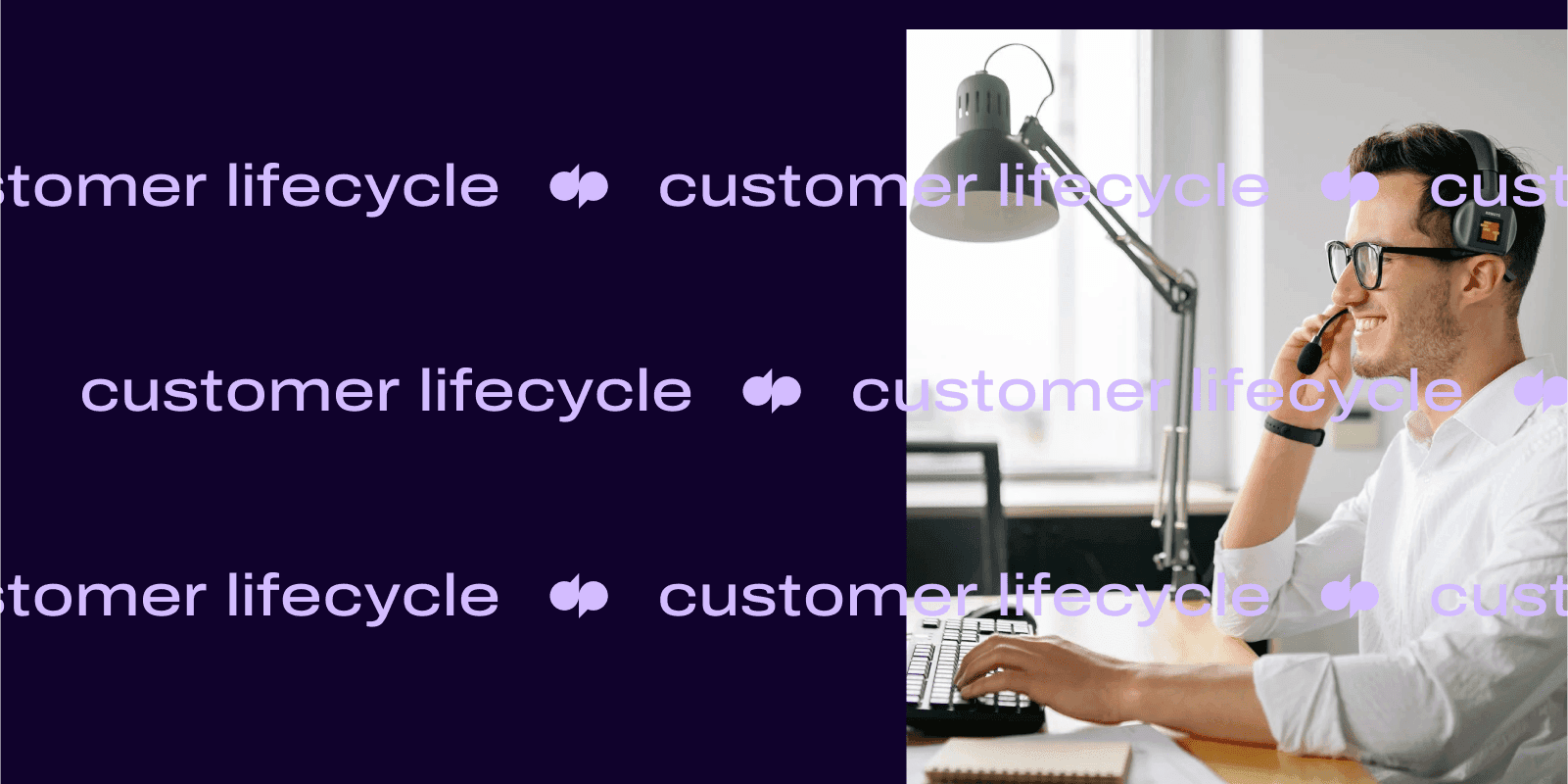
Share
Depending on the products or services you’re selling, managing the customer lifecycle can be hugely important. The more expensive or complicated your product, the more you need to be aware of the different stages in that cycle to maintain (and increase) your customer lifetime value.
As a Lifecycle Marketing Manager, I spend a significant portion of time coming up with strategies and working cross-functionally to turn customers into long-term brand advocates, increase customer retention, and so on.
What is a customer lifecycle?
First, it’s important to note that there’s a difference between customer lifecycle vs customer journey.
The customer journey (also called a buyer’s journey) basically covers all the interactions someone has with your business. The customer lifecycle, on the other hand, refers to the progression of steps a customer goes through before, during, and after they make a purchase.
In just a bit, I’ll walk you through key steps in customer lifecycle management (sometimes called CLM), and how you can better understand and manage those different stages, from running marketing campaigns to optimizing conversion rates.
But first, let’s look at an important metric that underpins customer lifecycle management: CLV, or customer lifetime value.
How to calculate customer lifetime value
Customer lifetime value is the net amount of revenue that a single customer contributes over the entire period in which they do business with you. Typically, you look at the sum of that individual customer’s purchases over a set period.
There are two formulas you can use. The simplest version is to add together all the revenue earned from a customer in one year, multiply it by the average customer lifespan, and subtract the acquisition cost:
(Customer’s annual revenue x Average lifespan) – Cost of customer acquisition = Customer lifetime value
This formula is best used if your customers spend a consistent amount during the year. If not, you can use a traditional formula that takes revenue fluctuations into account.
You’ll need to know the average gross margin for the individual customer’s lifespan, the retention rate, and the discount rate:
Average gross margin x (Customer retention rate / [1+ Discount rate – Customer retention rate])
How many customer lifecycle stages are there?
There’s no definitive answer! You’ll find people referring to four, five, six, or even more stages. These might include:
Discovery/Awareness
Education
Purchase / Conversion
Post-Purchase
In my experience, the customer lifecycle is best summed up by four stages starting with customer acquisition and ending with advocacy.
These are key stages in a customer lifecycle and where you should keep a close eye on customer engagement KPIs and your customer lifecycle marketing strategies.
1. Acquisition
Working at Dialpad, my customer lifecycle model starts with acquisition, which in our case includes the critical period where potential customers are wondering if our product can ease a particular pain point. In this stage, they’re comparing different brands, and you need to pique their interest and show them why you’re the best choice.
Once your prospect decides to make contact, it’s time to discuss their individual needs. Tell them more about your company, and direct them to testimonials from happy customers. Make sure your website explains your products and services so they can read more at their convenience.
At this point, ideally you’re available to answer any questions for prospects at their preferred time, and on their preferred channel. If you’re hard to get hold of, you’ll probably lose them forever. That’s why it’s important to have a range of communication channels and be able to manage inquiries efficiently. With Dialpad's unified communications platform, I (and our Sales team) can have phone calls, video meetings, and even messaging conversations on the go with prospects and customers, all from a single app:

2. Activation (Adoption)
If the prospect is happy with the experience so far, they’ll go ahead with the purchase. Having converted them into an actual customer, you now need to deliver your immediate post-purchase experience. Depending on your business and industry, a proactive approach and the right customer service techniques, can help you increase engagement and motivate them to buy from you again in the future.
This might include helping them learn more about their new purchase and making sure they get the most out of it. For example, if they bought a smart TV, but they don’t know how to access all the awesome bells and whistles, they won’t be as impressed as they might’ve been otherwise.
Understanding the customer lifecycle helps you to break down what the customer needs to achieve in clear steps. You can then adapt your processes and use the right tools to make these steps as easy and seamless as possible for your customers.
3. Retention
Retention is an important part of any customer lifecycle strategy. Conversion is only the beginning of a customer’s relationship with you, and you need to nurture that relationship if you want to achieve a high CLV. By this point, there’s a ton of evidence supporting the hypothesis that acquiring new customers costs a business more than retaining existing ones.
What does that mean for us lifecycle marketing managers? Instead of bombarding customers with information or offers right after their first purchase, maybe check in on how they’re doing with your product or service first. (Is it working the way they expected? Do they need help with onboarding?)
(This is a good touchpoint for a CSAT or customer satisfaction survey—it’ll help you find out if there’s a way to improve this experience for new customers.)
The retention stage can be long. Once you’ve got a customer, you want to keep them for the long term. For many companies, this task falls to their customer support or customer success team. Other than training your agents well, it’s also important to make sure they’re equipped with the tools to help your customers.
For example, our agents use Dialpad Ai Contact Center, which comes with a ton of functionality that’s designed to empower agents. There’s the Real-Time Assist (RTA) card feature, which are essentially tailored notes that pop up when customers say certain keywords or phrases on a call. Supervisors can create RTA cards and set them to trigger when tricky topics like “pricing” or “refund policy” and so on come up:
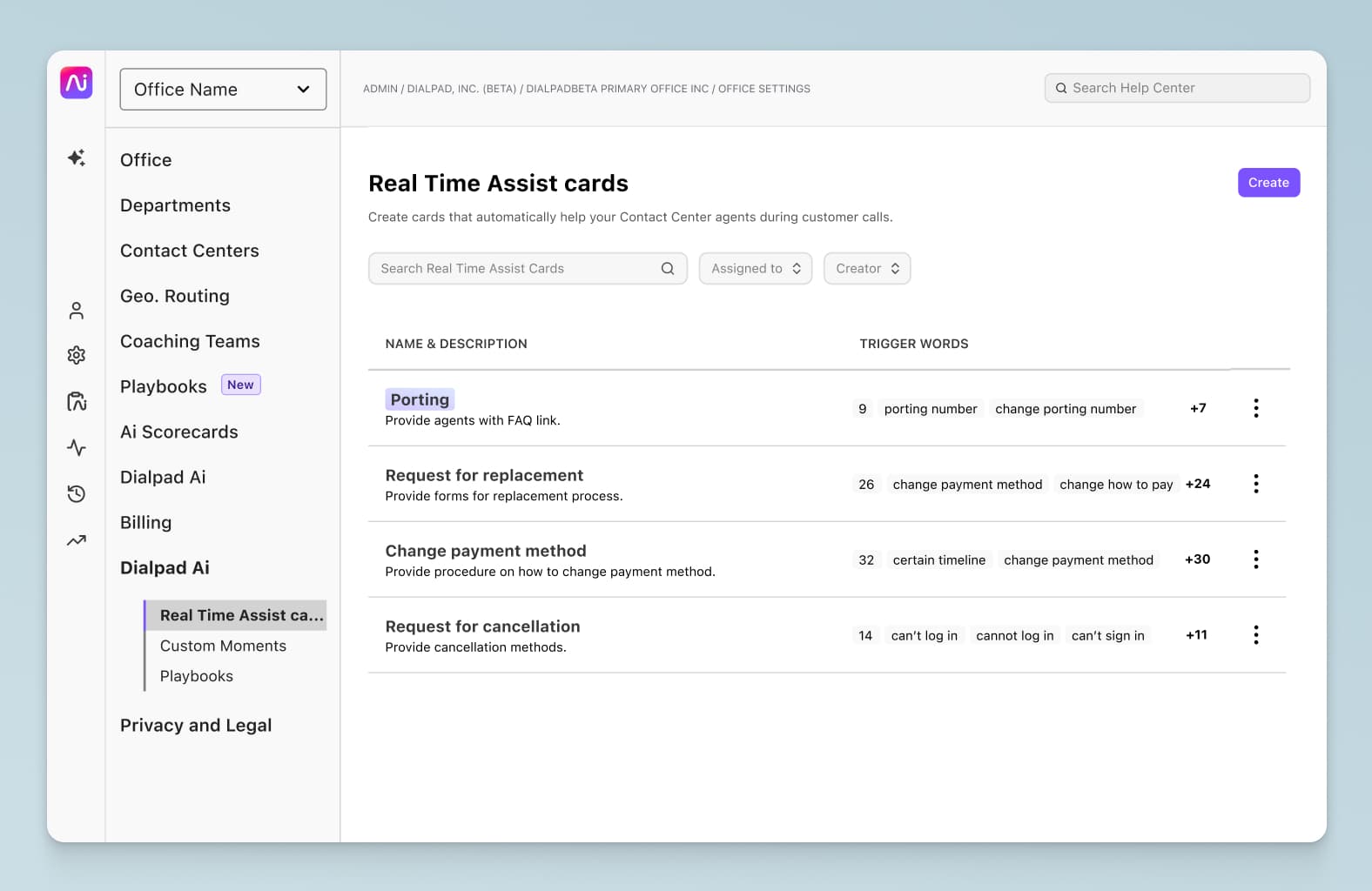
4. Advocacy and expansion
Brand loyalty is one thing, but ideally, you don’t just want loyal customers who just stick around for the long haul. You want to be able to upsell and cross-sell too.
Equally importantly, you want these customers to become advocates for you, because this kind of word-of-mouth will likely be more effective than any marketing you can do on your own. Customers who are happy with their experience with your business will tell their colleagues and friends, write positive reviews, and even share your content—helping you to expand your customer base.
7 customer lifecycle management best practices
1. Understand your customer
The first part of your customer lifecycle management strategy involves gaining in-depth knowledge of your customers.
Whether you’re an ecommerce or SaaS company, you should understand at the very least, what your customers like and dislike, what time of year they tend to start their buying journey, and how they might evaluate your products or services.
You might want to take note of their online habits, and which channels they prefer to be contacted on. Again, having an omnichannel customer experience is expected in many industries today.
All of these customer insights should be logged in your CRM (customer relationship management) software. This way, anyone on your support or sales team can quickly pull up a customer’s relationship history with your company and continue that conversation or relationship.
Fun fact: Dialpad integrates with a range of CRMs, including Salesforce, HubSpot, and Zoho CRM to automate a few important things. It embeds a dialer inside these CRMs (so your team doesn’t have to toggle back and forth between windows while on a call with a customer), and also automatically logs activities like calls and texts to help reduce repetitive data entry work:
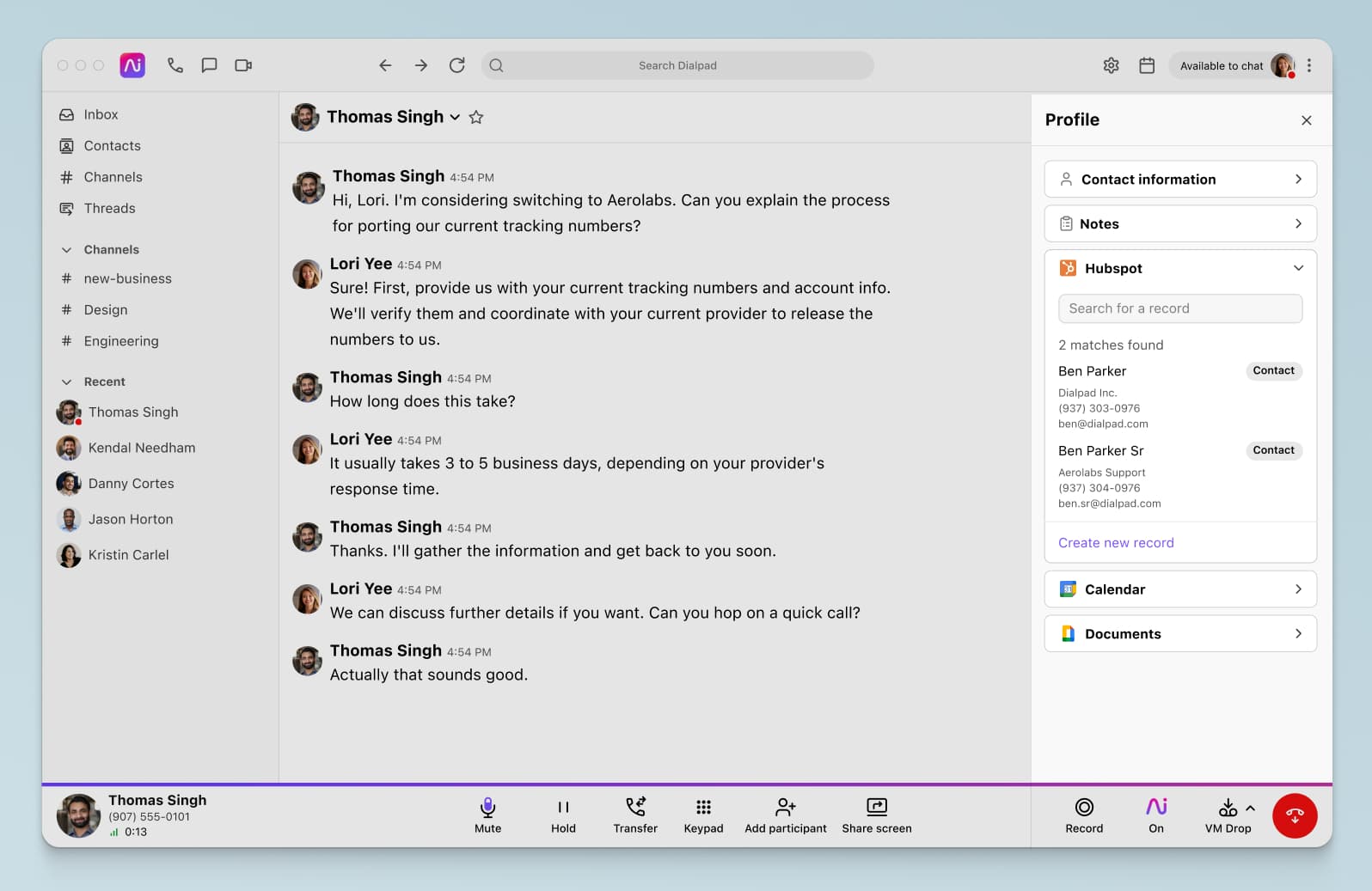
👉DIALPAD TIP:
If you’re not already using AI in customer service, it might be time to consider it. From live sentiment analysis to real-time assists for agents, to chatbots (that are actually helpful), there are a ton of things that AI can do to make agents’ and supervisors’ lives easier.
2. Make it easy for customers to self serve
Automations can be a huge time saver. Besides marketing automations, there are also other ways to automate certain parts of the customer experience (while still keeping the human touch).
For example, you could use a customer service chatbot to answer a wide range of questions that may not need an actual agent—”what’s your refund policy?” and “when are your business hours?” are just a few of the questions that you could easily help customers find the answers to on their own through an FAQ page or chatbot.
Hey, maybe they don’t want to talk to a human while they’re still making a decision and want to avoid being given the hard sell. (Not that your well-trained reps would do that!)
Self-service options also reduce the burden on your customer support team, and are a key part of a good digital customer engagement strategy today. And yes, an online Help Center counts:
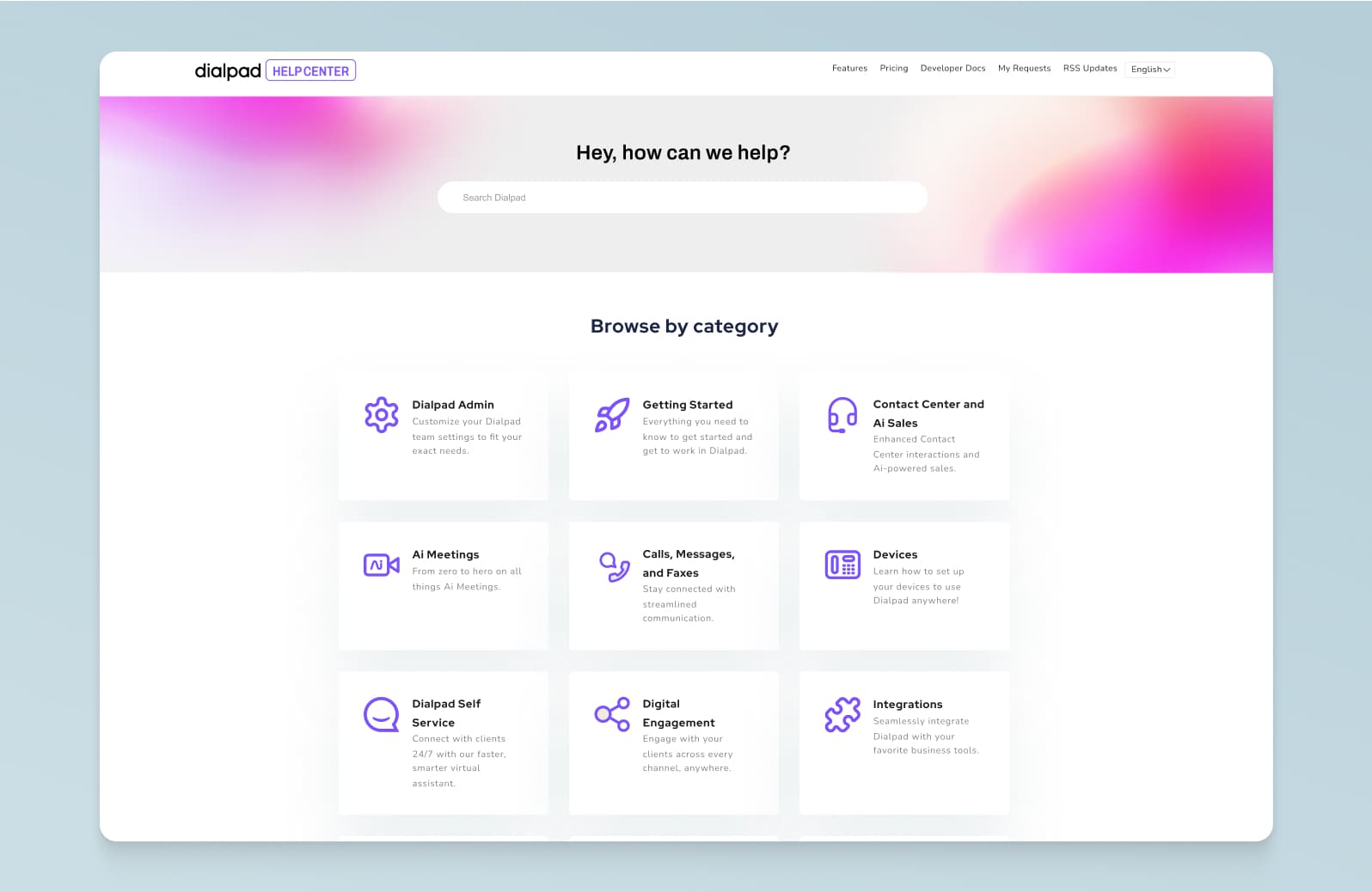
3. Identify the most common gaps where customers will need to speak with a person
Customer lifecycle and self-service automations are great, but there will always be times when you need to have a conversation with a human.
Maybe your customers are interacting with your product for the first time and just need a little guidance. Or maybe they have a complicated pricing question.
You should always, always have an easy way for customers to escalate their automated interactions, like chatbot conversations, to a live call with a person. With Dialpad's cloud contact center solution, for instance, our supervisors can not only drag and drop to create chatbot response flows, but also add an option to let a customer start a voice call or video call with an agent if the chatbot support isn’t working out:
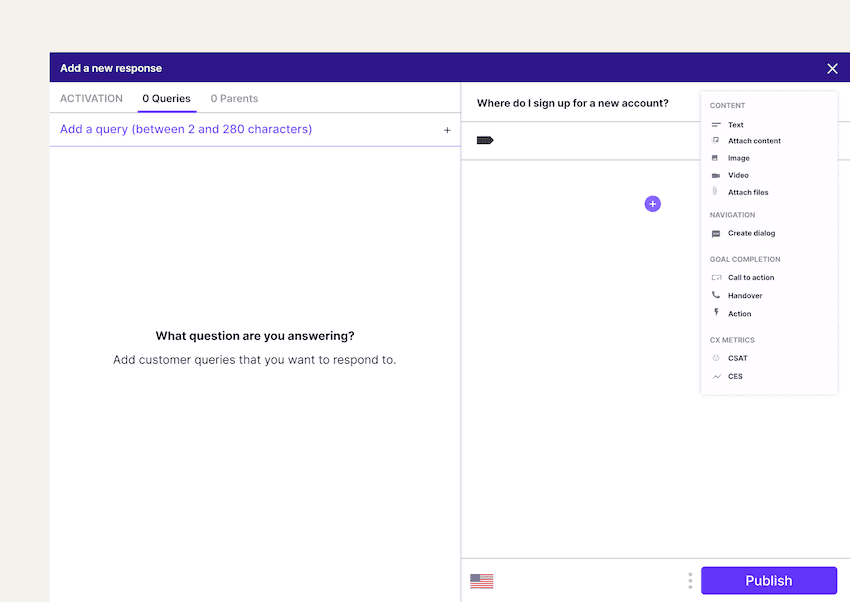
This way, you get the best of both worlds, without sacrificing the customer experience.
4. Don’t forget about the post-purchase stage
The post-purchase stage is critical in the customer lifecycle management process. If you lose interest in your customer after making a sale, you’re missing out on a huge opportunity. This is an important stage where you should continue (and even increase) the personalization you used in the acquisition stage to win that customer in the first place.
For instance, you could set up an automated email system that sends a thank-you note after a purchase and asks the customer if they’ll help you out by taking a survey or writing a review because their feedback is important to you.
5. Make sure your data is centralized
After acquisition, customers will be interacting with you in different ways—which means you’ll need a whole new data set. Along with the data you already have, it all needs to be centralized so that everything is accessible for multiple teams, making it easy to search conversation threads, call recordings, and notes about customer preferences.
Accessible customer data is important for future interactions, because a customer won’t necessarily communicate with the same rep or agent each time. Whoever answers a query should have the relevant details on hand so the customer feels like the company knows them, and they don’t have to repeat the story over again.
This is something that our support and sales team love about Dialpad—all of their communications with customers are logged in one place and integrated with our CRM, and even if an agent has never spoken to a customer before, they can quickly get full context in seconds and pick up that conversation. Customers tend to love that!
6. Don't do things in a silo
On a related note, the customer lifecycle usually involves many teams: Product, Sales, Professional Services, Customer Support, just to name a few. It’s crucial that they don’t operate in silos—the more the teams understand about each stage of the lifecycle, the more they can collaboratively deliver on customer needs.
A good customer lifecycle management system requires cross-team collaboration. If the marketers launch a new campaign, let the sales team know to expect a higher volume of inquiries. If the support team has been receiving complaints about a product, the design team must be informed. (And everyone should be aware of your customer service objectives.)
The best way to avoid silos is to develop a truly collaborative culture—which is much easier to do when you have the right communication tools. Our team uses Dialpad to have phone calls, video meetings, and messaging conversations, all in a single app. We don’t have to toggle between a video conferencing app and a separate messaging tool, and it just makes things a lot easier:
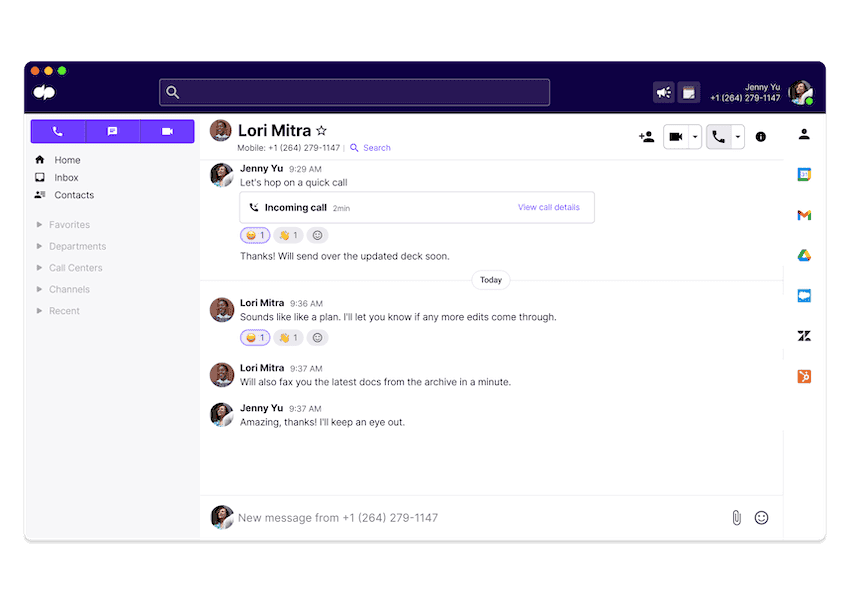
7. Don't neglect the referral engine
Customers trust referrals from people they know. So, instead of tooting your own horn about how great your product is, you need to encourage your best customers to spread the word. (Maybe help them along by offering an incentive.)
Lots of companies have used referral campaigns as part of their customer lifecycle marketing strategy by offering a discount or a small gift if customers refer a friend or leave a review (check out some customer review examples). It all helps with engagement and customer loyalty, and you can have a lot of fun with your marketing and advocacy programs.
How to create a customer lifecycle map in 5 steps
Customer lifecycle mapping is helpful because it makes it easier to spot areas for improvement, optimize your existing touchpoints, and develop more effective marketing, sales, and retention strategies. Here are the five steps that I usually take when creating a customer lifecycle map.
1. Create a customer persona to define your target audience
One of the best ways to ensure you’re delivering relevant content is to have a clear idea of who you're trying to reach. Yes, there’s room for hyper-personalization further down the line—but as a starting point, the easiest way to define your target audience is to create buyer personas.
Think of your buyer personas as fictional “characters” who represent the demographic and characteristics of your desired customer base.
You can have some fun creating these, giving each one a name and a backstory. Include everything from their age, family status, and job role to their preferred social media channels and their personal and professional goals. Then you can determine which of these characters should receive which messages.
2. Decide which parts of the customer lifecycle you need to map
Successful customer lifecycle management is about moving customers through all the stages of your funnel efficiently, but you might decide that your map should focus on particular sections of the lifecycle (such as expanding your customer accounts).
Once you’ve decided what you want to map, you can create a “behavior line” to describe what your customer does at this stage. For instance, how do you communicate to a customer that they can upgrade their account to unlock more features—do you create an in-app notification, run a social media ad, or do something else?
3. Identify all the actions a buyer takes during their interactions with your brand
Now, make a list of all the actions taken by a customer at different stages of the customer lifecycle. This could include browsing your website, clicking on a CTA button for a free demo, entering the purchase stage, seeking post-purchase support, and becoming a repeat customer.
Identify any obstacles or pain points your customer might face when taking these actions. Can they find product descriptions? Does your site display information on data privacy and refunds? Is it easy to share content? Look at your customer effort scores to find out, and make sure you have quality management in place so that each action is as frictionless as possible.
4. Map out all your customer touchpoints
The next step is to identify every customer touchpoint where a potential or existing customer could make contact with your brand. This includes all your communication channels—social media, email, phone, SMS—as well as self-service elements on your website.
Are you making it simple to get in touch? Are you responding quickly to inquiries, and engaging with followers on social media? Do you have easy access to customer data when an interaction begins? Also consider your email marketing efforts—are people taking the desired action when they receive an offer?
You can make this part of your customer lifecycle analysis, evaluating how quickly customers are moving through the pipeline and how you can improve each touchpoint to facilitate this.
5. Regularly look for ways to better support customers and improve their experience
Whether your current goal is to increase retention or get more customers to the advocacy stage, keep in mind that this is an ongoing process—not a one-off project.
You might need to regularly audit your live chat to see if there are certain trends in customers trying to get technical support using that channel. Or, you might notice that new customers are churning (leaving your company) soon after their onboarding.
There’s a variety of customer lifecycle metrics and KPIs that you’ll need to track, from product usage to conversion and retention rates, to CSAT scores, and more. Know your industry benchmarks and check your performance against them on a regular basis.
👉 Dialpad tip:
Not all metrics are directly tied to revenue, but they may be crucial for monitoring customer health!
Ready to grow your business with customer lifecycle management?
Managing the customer lifecycle can be a tough gig, and ideally, you’d have more than one person on the team working on it.
Not only do you have to understand what your customers need at every stage, you also have to be strategic in finding ways to make them feel valued—and more importantly, inclined to spend more with your company.
Hyper-personalization, engaging content, and robust support are all important tactics to think about in your customer lifecycle management program, and will play a key role in helping you get more customers to the loyalty stage and beyond.
If you’re looking for the right tools to help your team communicate effectively with customers (while working from anywhere) and support your contact center agents, why not check out Dialpad?
See how we use Dialpad to help us communicate with customers throughout the lifecycle
Get a personal walkthrough of Dialpad with someone from our team, or take a self-guided interactive tour of the app on your own first!








